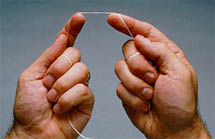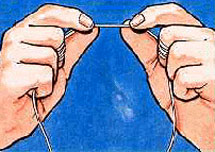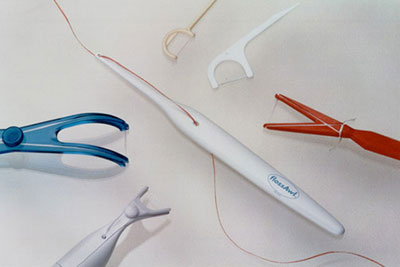 CELEBRATING **25** YEARS OF DENTAL EXCELLENCE | | ISO 9001:2000 CERTIFIED |
A2 AASHIRWAD, II CROSS LANE, LOKHANDWALA COMPLEX, ANDHERI (WEST), MUMBAI 400053, INDIA | 2632 8682 / 3082 7053 / 98193 63215 |
 CELEBRATING **25** YEARS OF DENTAL EXCELLENCE | | ISO 9001:2000 CERTIFIED |
A2 AASHIRWAD, II CROSS LANE, LOKHANDWALA COMPLEX, ANDHERI (WEST), MUMBAI 400053, INDIA | 2632 8682 / 3082 7053 / 98193 63215 |
| Antibiotics | Baby Teeth | Bad Breath | Bleaching | Bonding | Brushing | Bruxism | Caries (Decay) | Cosmetic Dentistry | Crowns & Bridges | Dentures | Dry Mouth | Emergencies | Endodontics | Extraction | Flossing | Gum Disease | Implants | Migraine | NTI | Oral Cancer | Orthodontia | Pregnancy | Preventive | Sealants | Silver fillings | Tobacco | Toothpastes | Veneers | Wisdom Teeth | XRays |
|
FLOSSING OF TEETH |
|
WHY BOTHER TO FLOSS? |
|
Periodontal disease is one of the most prevalent degenerative conditions in India, afflicting adults beginning in their late 20's. It is the disease that causes people to lose their teeth by slowly dissolving the supporting bone structure surrounding teeth. The most common symptoms of the disease are BAD BREATH and BLEEDING GUMS. Flossing is a simple oral hygiene procedure that, when performed daily, can insure healthy gums and teeth that last a lifetime. Experts say it's as indispensable to a healthy mouth as brushing, yet most people find it uncomfortable and don't do it regularly. Modern dentistry and dental products have begun to address the problem of plaque buildup which causes periodontal disease. New toothbrush designs, mouthwash and toothpaste formulations are being produced to specifically address the need for plaque reduction. Despite the boldly-advertised claims of these new products, a simple brushing and flossing regimen is the most effective way to reduce plaque and the problems it causes. | ||
Flossing is one of those things that people should do, but most
somehow find an excuse not to. Actually, there is good reason not
to floss. It's a real pain. If you think about it, flossing the front part of your mouth is easy and does not pose any difficulty. It is the rear area of the mouth that poses the challenge and is the toughest part to reach.
The rear teeth are difficult to reach because the fingers have to
extend further into the mouth.It's easy to put your index finger
on the cheek side and touch your rear tooth. Putting your index
finger in the middle of your mouth (tongue part), to touch the
rear tooth, is more difficult because your front teeth are almost
touching your knuckles. To put the fingers of both hands in your
mouth at the same time, as required in flossing, is very difficult; your jaw can only expand so far and your mouth can only stretch so far.
Take a piece of floss (12-18 inches), and wind it around the index finger of each hand. 
Grasp floss firmly between the thumb and index finger arriving at the flossing position.The fingers are separated by about an inch 
Use the thumbs to guide the floss between the upper teeth and use the index fingers to direct the floss between the lower teeth. 
Using a gentle sawing motion, guide the floss between your teeth. Never snap the floss into the gums. 
Curve floss around the tooth.Gently slide the floss up and down the side of the tooth and under gumline. Advance floss, after cleaning each side of tooth, by wrapping the floss around the finger of one hand, and unwrapping it on the other. Assume the flossing position,and continue to floss the side of each tooth until done.
There are only 3 brands of floss available in India:
Johnson & Johnson-the oldest
| ||
The two most important aspects of flossing are: wrapping the floss around the tooth and using a new section of floss for each contact. Wrapping allows the floss to go below the gumline, to remove plaque in areas that a toothbrush doesn't reach. Using a new section of floss allows the plaque to be removed. If the same section is used, the bacteria is redistributed to other areas.
Currently, there are no major options for floss holders. 
The standard floss holder is ‘Y' shaped and looks like a slingshot or forked prong device, where the floss is strung taut between the two prongs (there are many variations, see photograph above). The advantage of using a floss holder is the accessibility it affords to otherwise inaccessible areas.The limitation is that the floss cannot wrap around or conform to the tooth. The 'taut' floss can cut the gumline in the front and back of the tooth where it rises.It is cumbersome to 'advance' soiled floss and cannot be used with bridges.It has to be used very carefully. |
|
RELATED NEWS ITEMS |
| Antibiotics | Baby Teeth | Bad Breath | Bleaching | Bonding | Brushing | Bruxism | Caries (Decay) | Cosmetic Dentistry | Crowns & Bridges | Dentures | Dry Mouth | Emergencies | Endodontics | Extraction | Flossing | Gum Disease | Implants | Migraine | NTI | Oral Cancer | Orthodontia | Pregnancy | Preventive | Sealants | Silver fillings | Tobacco | Toothpastes | Veneers | Wisdom Teeth | XRays | Dental Tourism |